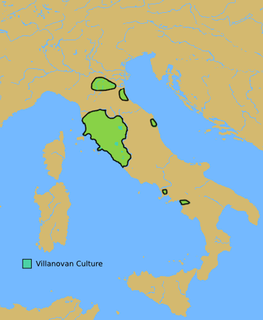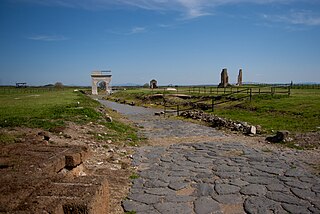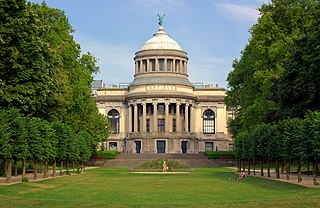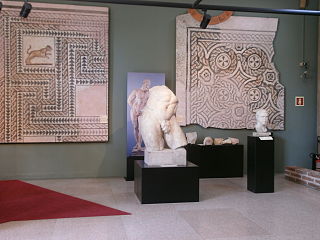
The Etruscan civilization was a civilization of ancient Italy in the area corresponding roughly to Tuscany, western Umbria, northern Lazio, with offshoots also to the north in the Po Valley, in the current Emilia-Romagna, south-eastern Lombardy and southern Veneto, and to the south, in some areas of Campania.

Adria is a town and comune in the province of Rovigo in the Veneto region of northern Italy, situated between the mouths of the rivers Adige and Po. The remains of the Etruscan city of Atria or Hatria are to be found below the modern city, three to four metres below the current level. Adria and Spina were the Etruscan ports and depots for Felsina. Adria may have given its name during an early period to the Adriatic Sea, to which it was connected by channels.
The strigil is a tool for the cleansing of the body by scraping off dirt, perspiration, and oil that was applied before bathing in Ancient Greek and Roman cultures. In these cultures the strigil was primarily used by men, specifically male athletes; however, in Etruscan culture there is evidence of strigils being used by both sexes. The standard design is a curved blade with a handle, all of which is made of metal.

Cerveteri is a town and comune of northern Lazio in the region of the Metropolitan City of Rome. Known by the ancient Romans as Caere, and previously by the Etruscans as Caisra or Cisra, and as Agylla by the Greeks, its modern name derives from Caere Vetus used in the 13th century to distinguish it from Caere Novum.

The Villanovan culture, regarded as the oldest phase of Etruscan civilization, was the earliest Iron Age culture of Central Italy and Northern Italy. It directly followed the Bronze Age Proto-Villanovan culture which branched off from the Urnfield culture of Central Europe. This gave way in the 7th century BC to an increasingly orientalizing culture influenced by Greek traders and colonists who settled in South Italy.

The Capitoline Museums is a single museum containing a group of art and archaeological museums in Piazza del Campidoglio, on top of the Capitoline Hill in Rome, Italy. The historic seats of the museums are Palazzo dei Conservatori and Palazzo Nuovo, facing on the central trapezoidal piazza in a plan conceived by Michelangelo in 1536 and executed over a period of more than 400 years. The history of the museum can be traced to 1471, when Pope Sixtus IV donated a collection of important ancient bronzes to the people of Rome and located them on the Capitoline Hill. Since then, the museums' collection has grown to include many ancient Roman statues, inscriptions, and other artifacts; a collection of medieval and Renaissance art; and collections of jewels, coins, and other items. The museums are owned and operated by the municipality of Rome.

Vulci or Volci was a rich and important Etruscan city.

Populonia or Populonia Alta today is a frazione of the comune of Piombino. As of 2009 its population was 17. Populonia is especially noteworthy for its Etruscan remains, including one of the main necropolis in Italy, discovered by Isidoro Falchi.

The Staatliche Antikensammlungen is a museum in Munich's Kunstareal holding Bavaria's collections of antiquities from Greece, Etruria and Rome, though the sculpture collection is located in the opposite Glyptothek and works created in Bavaria are on display in a separate museum. Ancient Egypt also has its own museum.

Etruscan art was produced by the Etruscan civilization in central Italy between the 10th and 1st centuries BC. From around 750 BC it was heavily influenced by Greek art, which was imported by the Etruscans, but always retained distinct characteristics. Particularly strong in this tradition were figurative sculpture in terracotta, wall-painting and metalworking especially in bronze. Jewellery and engraved gems of high quality were produced.

The National Archaeological Museum of Florence is an archaeological museum in Florence, Italy. It is located at 1 piazza Santissima Annunziata, in the Palazzo della Crocetta.

The prehistory of Italy began in the Paleolithic period, when the Homo species colonized the Italian territory for the first time, and ended in the Iron Age, when the first written records appeared in the Insular Italy.

The Art & History Museum is a public museum in Brussels, Belgium which is one of the constituents of the Royal Museums for Art and History (RMAH). It is located in the Cinquantenaire Park and was previously called the Cinquantenaire Museum. It is one of the largest museums in Europe.
The Archaeological Museum of Populonia, opened in 2001 in the town of Piombino, Italy, contains artifacts from what was the ancient territory of Populonia during a period ranging from prehistory to late antiquity. The museum contains an active center of experimental archaeology with a focus on the processing of ceramics and stone.
In the 8th century BC, the Etruscans expanded their power to Northern and Southern Italy, specifically towards Emilia and Campania, there they founded Etruscan dominions who are modernly known under the names of Padanian Etruria and Campanian Etruria. Moving from the northern city-states of the Etruscan Dodecapolis they swept into the Po valley through the Apennine passes.

Narce was a Faliscan settlement in Italy located 5 kilometers south of Falerii. Its residents spoke an Italic language related to Latin. It was inhabited from the 2nd millennium to the 3rd century B.C. The ancient name of the settlement is uncertain, but it may have been called Fescennium.

The Archaeological Museum of Milan is located in the ex-convent of the Monastero Maggiore, alongside the ancient church of San Maurizio al Monastero Maggiore, with entrance on Corso Magenta.

The Monterozzi necropolis is an Etruscan necropolis on a hill east of Tarquinia in Lazio, Italy. The necropolis has about 6,000 graves, the oldest of which dates to the 7th century BC. About 200 of the gravestones are decorated with frescos.

The Tarquinia National Museum is an archaeological museum dedicated to the Etruscan civilization in Tarquinia, Italy. Its collection consists primarily of the artifacts which were excavated from the Necropolis of Monterozzi to the east of the city. It is housed in the Palazzo Vitelleschi.

The Metropolitan City of Bologna is a metropolitan city in the Emilia Romagna region, Italy. Its capital is the city of Bologna. Replacing the Province of Bologna, it was first created by the reform of local authorities and then established by the Law 56/2014. It has been operative since January 1, 2015.




















